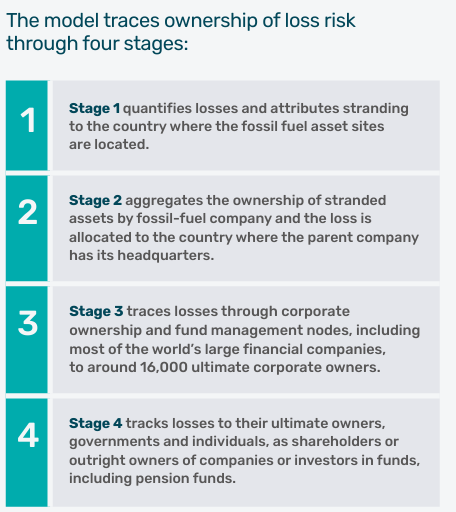While stranded asset concerns have
long been touted by environmentalists who erroneously think we are somehow on
the verge of eliminating fossil fuel use, the facts do not support such a
conclusion. Alternative energy sources are not yet even keeping up with demand
growth, although they have been getting closer. However, when such issues are
examined on a regional basis, there may be some legitimate concerns.
A
new report from the UK: Stranding: Modelling the UK’s Exposure to
At-Risk Fossil Fuel Assets by the UK Sustainable Investment and
Finance Association reports that in order to meet decarbonization pathway
goals, some fossil fuel assets risk becoming stranded in the UK. Of course, the
report assumes that those pathway targets will be able to be met, by utilizing
technologies like offshore wind, which have become more expensive in recent
years. The report seems to focus on the goal of staying below 1.5 degrees C,
which may have never really been technically possible. It’s all but certain that
the 1.5 deg C goal will not be met. They calculate $2.28 trillion in global
losses due to stranded assets by 2040 and $141 billion of UK exposure to
possible strandings. The list below of how assets may become stranded is
telling. The first one given, climate policies and regulations, can be seen as
self-imposed limitations on something in high demand. Second, the notion that
fossil fuel infrastructure will become uneconomical due again to emissions
regulations and also declining demand, is both self-imposed and unlikely in the
near-term demand is still robust. Thirdly, advances in solar, wind, and battery
technologies can help them be more competitive, but no big breakthroughs are
appearing on the horizon at present. Fourth, the idea that it will become
uneconomical to drill for hydrocarbons, is also not going to happen in the
foreseeable future due to robust demand. Fifth is the idea that consumers will
demand more renewable energy and less fossil fuels. This is another hope that
does not seem realistic anytime soon. Sixth, are legal and reputational risks,
more self-imposed regulatory control. I think it was the CEO of Duke Energy who
once said that all technologies have stranded asset risks and that these were
more manageable than often depicted. There are ways to reuse, repurpose, and
more likely to write down such assets. Devices like securitization bonds can be
employed.
Unfortunately,
stranded asset risks have been used as a tool of influence to discourage and
scrutinize fossil fuel investments. This should not be used for controlling
financing decisions, especially for projects in developing countries where
affordable modern energy access is more important than emissions.
Below
is a depiction of something called the FRANTIC model of four stages of asset
stranding that was used in the report.
As
can be seen in the graph below, the U.S. and Russia are most exposed to
stranded assets according to the report. This is no doubt due to the
well-developed oil & gas industries in both countries, including exports.
The 2nd graph below shows liabilities by regional owners, whether governments,
corporate entities, financers, individuals, fund owners, or others.
The
whole notion of stranding assets through regulation is self-imposed, as I
noted. It does not consider market conditions and supply and demand issues. It
also does not consider power reliability. There is a robust demand for natural
gas around the world. There is also an abundant supply of natural gas. It aids
power reliability. Most future power models, including sufficiently
decarbonized models, show increased use of natural gas in the near term. At
some point later, probably beyond 2035, demand may drop, if other technologies
are more competitive.
The
report gives four recommendations:
1. Create
positive, enabling conditions for decarbonising investment opportunities
2. Industrial
decarbonisation strategies
3. A
clear regulatory framework to support sustainable finance and transition
finance, including robust transition planning
4. UK
leadership on investor stewardship should be further cemented and continue to
evolve, including accounting for systemic stewardship approaches
The
report cites Bloomberg New Energy Finance that total global energy investment
and spending from 2024 to 2050 will be between $181 trillion and $215 trillion.
The report also notes the lack of detail in corporate energy transition plans.
That, I believe, is necessitated by the unknown cost and the generally high
cost and low profitability of clean energy investments. They want to address
the issue with a regulatory framework for energy transition financing. As
always, I prefer the carrot approach over the stick approach as does the
private sector. The report favors a regulatory approach to decarbonization, a
stick approach. I think that the best way to get more private sector approval
is to focus on carrot approaches like voluntary market mechanisms, tax credits,
and subsidies. Subsidization is a necessary carrot approach to make low-carbon
energy more competitive but shooting yourself in the foot by using stick
approaches to make fossil fuels more expensive when they are clearly in heavy
demand is just not smart. Oil demand is expected to plateau around 2030, says
the IEA, but the IEA does not have the greatest predictive record. It could
plateau for a decade. Any talk of the death of fossil fuels is greatly
exaggerated at best and delusional at worst.
References:
New
analysis predicts that $2.3 trillion worth of assets could be 'stranded' by
2035 — here's what that means. Beth Newhart. The Cool Down. March 24, 2025. New
analysis predicts that $2.3 trillion worth of assets could be 'stranded' by
2035 — here's what that means
Stranding:
Modelling the UK’s Exposure to At-Risk Fossil Fuel Assets. UK Sustainable
Investment and Finance Association. March 2025. UKSIF-Stranded-Assets-Report-March-2025.pdf










